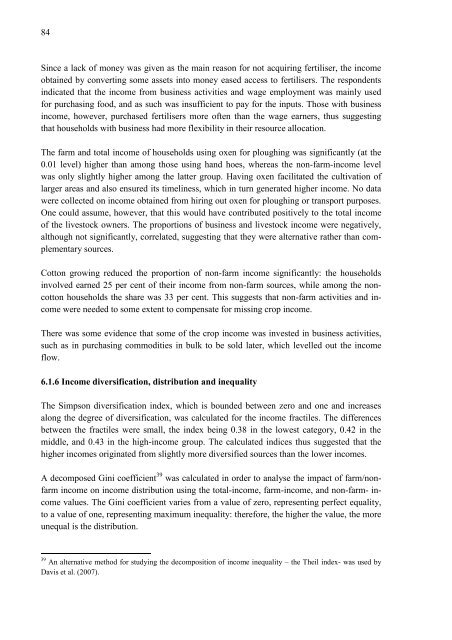Rural Income Generation and Diversification - A Case Study ... - Doria
Rural Income Generation and Diversification - A Case Study ... - Doria
Rural Income Generation and Diversification - A Case Study ... - Doria
You also want an ePaper? Increase the reach of your titles
YUMPU automatically turns print PDFs into web optimized ePapers that Google loves.
84<br />
Since a lack of money was given as the main reason for not acquiring fertiliser, the income<br />
obtained by converting some assets into money eased access to fertilisers. The respondents<br />
indicated that the income from business activities <strong>and</strong> wage employment was mainly used<br />
for purchasing food, <strong>and</strong> as such was insufficient to pay for the inputs. Those with business<br />
income, however, purchased fertilisers more often than the wage earners, thus suggesting<br />
that households with business had more flexibility in their resource allocation.<br />
The farm <strong>and</strong> total income of households using oxen for ploughing was significantly (at the<br />
0.01 level) higher than among those using h<strong>and</strong> hoes, whereas the non-farm-income level<br />
was only slightly higher among the latter group. Having oxen facilitated the cultivation of<br />
larger areas <strong>and</strong> also ensured its timeliness, which in turn generated higher income. No data<br />
were collected on income obtained from hiring out oxen for ploughing or transport purposes.<br />
One could assume, however, that this would have contributed positively to the total income<br />
of the livestock owners. The proportions of business <strong>and</strong> livestock income were negatively,<br />
although not significantly, correlated, suggesting that they were alternative rather than complementary<br />
sources.<br />
Cotton growing reduced the proportion of non-farm income significantly: the households<br />
involved earned 25 per cent of their income from non-farm sources, while among the noncotton<br />
households the share was 33 per cent. This suggests that non-farm activities <strong>and</strong> income<br />
were needed to some extent to compensate for missing crop income.<br />
There was some evidence that some of the crop income was invested in business activities,<br />
such as in purchasing commodities in bulk to be sold later, which levelled out the income<br />
flow.<br />
6.1.6 <strong>Income</strong> diversification, distribution <strong>and</strong> inequality<br />
The Simpson diversification index, which is bounded between zero <strong>and</strong> one <strong>and</strong> increases<br />
along the degree of diversification, was calculated for the income fractiles. The differences<br />
between the fractiles were small, the index being 0.38 in the lowest category, 0.42 in the<br />
middle, <strong>and</strong> 0.43 in the high-income group. The calculated indices thus suggested that the<br />
higher incomes originated from slightly more diversified sources than the lower incomes.<br />
A decomposed Gini coefficient 39 was calculated in order to analyse the impact of farm/nonfarm<br />
income on income distribution using the total-income, farm-income, <strong>and</strong> non-farm- income<br />
values. The Gini coefficient varies from a value of zero, representing perfect equality,<br />
to a value of one, representing maximum inequality: therefore, the higher the value, the more<br />
unequal is the distribution.<br />
39 An alternative method for studying the decomposition of income inequality – the Theil index- was used by<br />
Davis et al. (2007).

















